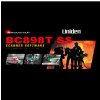Uniden BC898TSS English Owners Manual - Page 28
Searching Tips
 |
View all Uniden BC898TSS manuals
Add to My Manuals
Save this manual to your list of manuals |
Page 28 highlights
departments scramble or encrypt their communications, and you might want to lock out these unintelligible transmissions. To lock out an ID, press L/O when the ID appears. The ID is locked out, and the next active ID appears. You can lock out up to 200 ID's. Note: If you lock out an ID in search mode, it is also locked out in scan list mode. Conversely, if you lock out an ID while in scan list mode, it is locked out in search mode. Restoring a Single ID Follow these steps to unlock a single ID. 1. Hold down L/O until you hear two short beeps. 2. Use either the rotary tuner or HOLD U or LIMIT V to select the ID you want to unlock. 3. Press L/O. The ID is unlocked and the next locked ID appears. 4. Press SRC to return to the search mode. Restoring All ID's Follow these steps to unlock all locked out ID's at once: 1. Hold down L/O until you hear two short beeps. 2. Hold down L/O for about 2 seconds to unlock all the ID's at once. Note: If you unlock all the ID's, Non appears. Press SCAN to scan the ID's stored in your scan lists or press SRC to return to the search mode. 3. Press SRC to return to the search mode. Searching Tips ID Delay Mode Use the DELAY key to select the delay mode if it's not active. This mode holds an ID for 2 seconds while you wait for a reply. In a trunked system, you can set a delay for each bank. Other groups might use the system, but your scanner will only look for the ID in the display. Note: If you consistently miss responses while in ID delay mode, you might need to change the default system type or change the fleet map you are using. ID Hold Mode Press HOLD U to hold on a particular ID in the display. This is where the trunk tracking effect is really noticeable. You can hold a specific talk group, such as fire department onscene operations, no matter which frequency the group uses. 25















